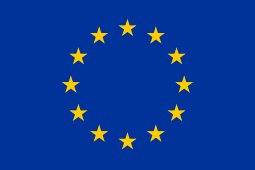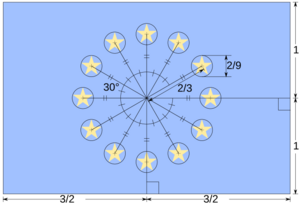Flag of Europe facts for kids
 |
|
| Name | European flag Flag of the Council of Europe Flag of the European Union Circle of stars |
|---|---|
| Use |
|
| Proportion | 2:3 |
| Adopted | 9 December 1955 (CoE) 29 June 1985 (EEC) |
| Design | A circle of twelve five-pointed yellow stars on a blue field. |
| Designed by | Collaborative effort involving various people, including Arsène Heitz and Paul M. G. Lévy |
The flag of Europe is a famous symbol for the whole continent of Europe. It has twelve golden stars arranged in a circle on a bright blue background. This flag is the official symbol of the European Union (EU).
The flag was first created and chosen in 1955 by the Council of Europe (CoE). The Council of Europe is an organization that works to protect human rights and democracy across Europe.
Later, in 1985, the flag also became a symbol for the European Union. Even though the EU has changed its name and structure over the years, it still uses this flag. Many countries in the EU have officially said they are proud to use this flag as a symbol of their union.
Contents
What the Flag Looks Like
The flag has a simple but strong design. It features a blue background, which is officially called "azure." On this blue background, there is a circle of twelve golden stars. These stars have five points, and they are arranged so that their points do not touch each other.
What the Flag Means
The flag of Europe is full of meaning. The blue background is like the sky, and it stands for truth and clear thinking. It's also a color often linked to the Virgin Mary.
The twelve golden stars are very important. They represent the people of Europe coming together. The number twelve was chosen because it is a symbol of perfection and completeness. Think of a clock with twelve hours, or the twelve months in a year – it shows something whole and finished. The stars are arranged in a circle to show unity and harmony among the European countries.
The golden color of the stars is like the sun. It symbolizes glory and bright ideas. The five points of each star can also represent hope and learning.
How the Flag Was Designed
The flag is a rectangle. Its width is one and a half times its height. The twelve yellow stars are placed in a perfect circle in the middle of the blue background.
Each star has five points and stands upright. They are spaced out evenly, just like the numbers on a clock face. The size of each star is exactly one-ninth of the flag's height.
The specific colors for the flag are:
- The blue background is called "Reflex Blue."
- The golden stars are simply "Yellow."
These colors make sure the flag looks the same everywhere it is used.
When the Flag Was Adopted and Used
The twelve-star "flag of Europe" was created in 1950. It was officially adopted by the Council of Europe in 1955.
Later, the European Parliament also started using this flag in 1983. In 1985, the European Council decided to use it as an "emblem" for the European Communities, which were the groups that came before the European Union.
When the European Union was formed in 1993, it continued to use this flag. Even though there were plans to make it the official flag written into the EU's main rules, this didn't happen. However, many EU countries have still declared their support for the flag as an important symbol. In 2007, the European Parliament officially adopted the flag for its own use.
See also
 In Spanish: Bandera de Europa para niños
In Spanish: Bandera de Europa para niños
- Symbols of Europe#Flag
- Symbols of the European Union


